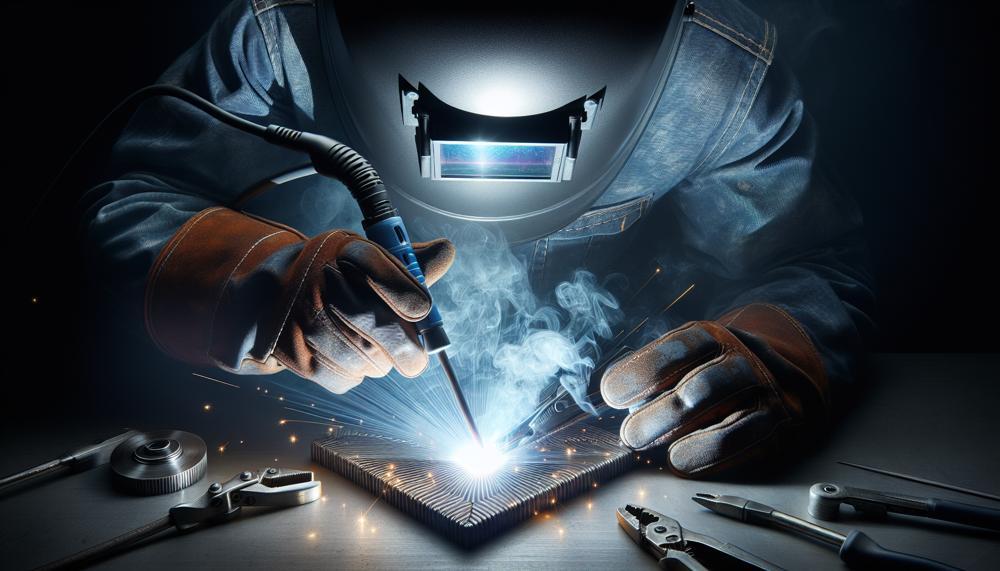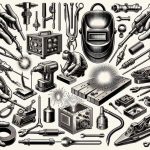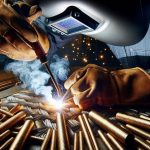Are you tired of pouring your time and effort into MIG welds, only to be disappointed with the end result? Look no further. In this blog post, we’ll delve into the world of MIG welding and uncover the secrets to determining the quality of your welds.
From mastering the fundamentals of MIG welding to recognizing common mistakes and techniques for improvement, we’ve got you covered.
Get ready to elevate your welding game with these crucial insights:
- Familiarize yourself with the various types of MIG welds and their specific applications.
- Understand the vital role of proper preparation and setup before beginning a weld.
- Identify common defects in MIG welds, such as porosity and lack of fusion.
- Discover expert tips and tricks for achieving robust, visually appealing welds.
- Boost your confidence in your welding skills by learning how to assess the quality of your finished product.
Whether you’re a novice or a seasoned pro, this post is tailored just for you. So grab your gear and let’s embark on a journey towards creating impeccable MIG welds that will withstand the test of time.
Contents
Weld Metal Porosity
Weld metal porosity is a common problem in MIG welding, which can result in weakened welds and potential failure. This happens when external gases get trapped in the welded joint, forming cavities or gaps. To prevent or minimize porosity in MIG welding, it’s crucial to understand the contributing factors and take necessary precautions.
Various factors can cause weld metal porosity, including insufficient shielding gas, wind interference, moisture on the weld joint, and improper welding techniques. In addition to these, there are specific considerations for MIG welding, such as surface condition, gas coverage, base metal properties, and heat input.
To prevent porosity caused by surface condition, it is vital to use a deoxidizer in the wire and thoroughly clean the base metal from any rust, oil, or paint. Maintaining an appropriate gas flow rate is also crucial to avoid contamination of the base metal, which can be determined using a flow meter.
Base metal properties, such as high sulfur content, can also contribute to porosity. Hence, selecting the correct amperage and wire feed speed is crucial for proper heat input and penetration into the base metal. Additionally, using the push technique and checking for undercut can help achieve a flatter bead shape for a more visually appealing weld.
Using the right equipment and settings is essential in minimizing weld metal porosity in MIG welding. This includes using the correct size contact tip and gun liner, ensuring sufficient work cables, and examining for faulty wire delivery. In case of porosity during welding, it’s crucial to remove it entirely before rewelding to prevent further contamination.
Improper Weld Bead Profile
Improper weld bead profiles are a common problem in MIG welding that can lead to weak or faulty welds.
To achieve high-quality welds, it is crucial to be able to identify the signs of an improper weld bead profile and address them accordingly. Some common indicators of an improper weld bead profile include:
- Inconsistent or abnormal weld shape: This is typically caused by incorrect voltage or wire feed speed settings, improper technique, or dirty work surfaces. Adjusting the voltage and wire feed speed, using the correct weaving technique, and ensuring a clean workspace can help correct this issue.
- Undercutting: This occurs when the edges of the base metal are melted away, leaving a groove along the weld joint. It is often caused by excessive heat or an incorrect welding angle. To fix this issue, reducing heat input and maintaining a proper welding angle is necessary.
- Excessive or insufficient penetration: This issue arises when the weld either penetrates too deeply or does not penetrate enough into the base metal. It can be caused by incorrect voltage or wire feed settings, improper technique, or dirty materials. To correct this problem, adjust the voltage and wire feed speed, use the appropriate technique, and ensure clean materials.
- Weld spatter: This refers to small bits of molten metal that splatter around the weld joint, resulting in a rough finish. It can be caused by incorrect voltage or wire feed speed, inadequate gas coverage, or contaminated materials. To prevent spatter, adjust the voltage and wire feed speed, ensure proper gas coverage, and use clean materials.
To address these issues with an improper weld bead profile, it is crucial to follow proper welding techniques, regularly maintain equipment, and use clean materials and work surfaces. Attention to detail and proactive problem-solving can help prevent these problems and produce top-notch welds.
Lack of Fusion
Lack of fusion is a welding defect commonly found in MIG welding, where the base metal and filler metal do not fuse correctly. This inadequate bonding can leave gaps or voids, compromising the weld’s strength and integrity.
There are several reasons why lack of fusion may occur, such as insufficient heat, incorrect travel speeds, improper welding techniques, incorrect torch angle, or using the wrong electrode type. These factors can prevent the base metal and filler metal from reaching the necessary melting point for proper fusion.
When a lack of fusion happens, it can cause different defects, including porosity, cracks, and lack of penetration. These flaws weaken the weld and make it more prone to failure under stress. For instance, if there is a lack of penetration due to inadequate fusion, the resulting shallow weld may not withstand heavy loads.
To address lack of fusion, welders can make adjustments to welding settings by increasing voltage or wire feed speed to increase heat output. It is also crucial to use proper welding techniques and maintain a clean workspace to ensure proper fusion between the two metals. Holding the electrode steady and at the correct angle can also help improve fusion.
Faulty Wire Delivery
Faulty wire delivery can have a significant impact on the quality of a MIG weld. This refers to any problems that may arise with the wire as it is fed into the welding gun. A consistent and steady wire feed is essential for creating a smooth and strong weld. However, when issues with wire delivery occur, it can result in various problems with the weld, such as lack of fusion, splatter, and inconsistent penetration.
To gain a better understanding of how faulty wire delivery affects the quality of a MIG weld, let’s delve into some of the specific issues that can arise and their consequences:

- Unstable Arc: Uneven or inconsistent wire feeding can cause the arc to be unstable and erratic. This leads to an uneven and flawed weld, making it difficult to achieve proper penetration and fusion between the base and filler metals.
- Burnback: This occurs when the wire melts too close to the contact tip, causing it to fuse or get stuck. This can interrupt the welding process and result in poor quality welds.
- Inconsistent Feed: An inconsistent wire feed can lead to an uneven weld bead. This creates weak spots in the weld, making it more prone to failure.
- Contact Tip Problems: Faulty wire delivery can also cause issues with the contact tip, such as clogging or burnout. This can result in an unstable arc and poor quality welds.
To prevent these issues and ensure proper wire delivery, it is important to regularly inspect and maintain your welding equipment. This includes checking for any kinks or blockages in the wire, ensuring proper tension on the wire spool, and replacing worn out contact tips.
In addition, using high-quality wires and ensuring they are properly aligned in the welding gun can also help prevent faulty wire delivery. Overall, addressing and troubleshooting any problems with wire delivery is crucial for achieving high-quality MIG welds.
Faulty wire delivery can greatly affect the quality of a MIG weld. This refers to any issues that arise with the wire as it is being fed into the welding gun. A consistent and steady feed of wire is crucial for producing a smooth and strong weld. When there are problems with wire delivery, it can result in various issues with the weld, such as lack of fusion, splatter, and inconsistent penetration.
Conclusion
In conclusion, creating high-quality MIG welds requires a combination of expertise, precision, and attention to detail. By familiarizing yourself with the various types of MIG welds and their specific applications, understanding the significance of preparation and setup, identifying common defects, and implementing expert tips and tricks, you can elevate your welding skills and produce flawless welds that will withstand the test of time.
From preventing porosity in weld metal through proper surface preparation and gas coverage to addressing issues with an incorrect weld bead profile by following correct techniques and maintaining equipment, this blog post has covered all the essential aspects. Furthermore, we have delved into the impact of lack of fusion on weld quality and how faulty wire delivery can affect the final outcome.
Whether you’re a beginner or an experienced professional, keep these crucial insights in mind to boost your confidence in your welding abilities and create visually stunning, sturdy MIG welds. Remember to regularly inspect and maintain your equipment, use high-quality materials, and always strive for perfection.





